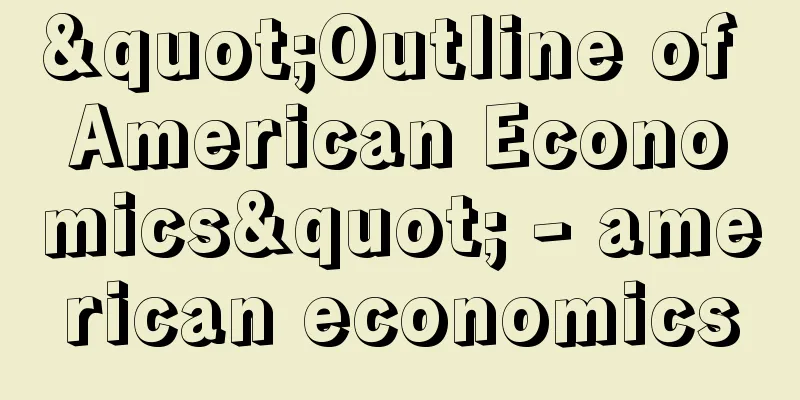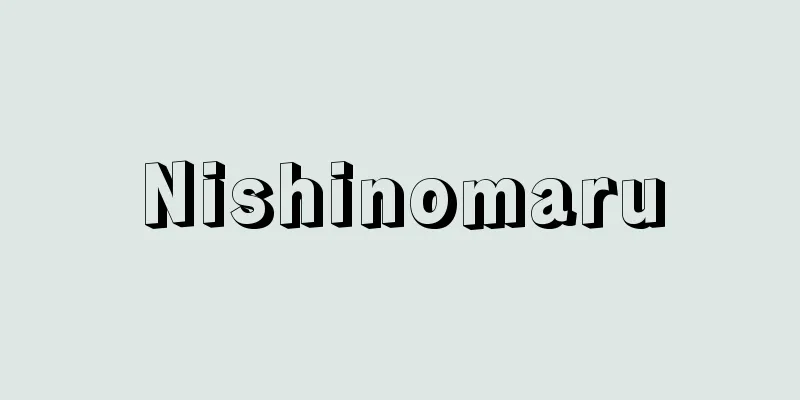Wooden tablets

|
A strip of wood with characters written on it in ink. Examples of using wood as a writing material can be found in Western Europe, such as in ancient Rome, but in ancient China, before the invention of paper, bamboo and wooden tablets were produced, which eventually influenced Japan as well. In Japan, it was used in conjunction with paper as a writing material from the Asuka period in the 7th century until the early modern period, but its value as a document is particularly important in ancient times (around the 7th to 10th centuries), when written historical materials were limited. [Yoshitaka Mikami September 19, 2018] The excavation status of wooden tablets in JapanIt has long been known that mokkan in Japan were handed down among the Shosoin treasures of Todaiji Temple in Nara, and the first examples of mokkan to be excavated include the Yui ruins in Mie Prefecture in 1928 (Showa 3) and the Hotta no Saku ruins in Akita Prefecture in 1930. However, at this stage, only a small number of pieces were excavated, and mokkan were not yet fully recognized as ancient materials. In 1961, a large number of 41 wooden tablets were discovered at the Heijo Palace ruins in Nara Prefecture, and this marked the beginning of full-scale research and study of wooden tablets. This led to the clear recognition that wooden tablets were ancient materials. As excavations at imperial capitals such as the Heijo Palace and the Fujiwara Palace progressed, the number of wooden tablets unearthed also increased. Wooden tablets were also discovered at local government offices (centres of local politics) such as the Dazai Palace ruins in Fukuoka Prefecture and the Taga Castle ruins in Miyagi Prefecture, which are similar in nature to the imperial capitals, and wooden tablets began to be excavated all over the country. In light of this situation, the Wooden Tablet Society was established in 1979, and information on wooden tablet excavations from all over the country was collected at a research conference held every December. Furthermore, the magazine "Wooden Tablet Research" was published once a year, and information was accumulated, leading to a dramatic increase in the number of wooden tablet excavations. Particularly noteworthy discoveries were the "Nagaya Oke mokkan" and "Nijo Oji mokkan," which were discovered at the Heijo-kyo ruins between 1988 and 1989 (Heisei 1). The combined total of these exceeded 100,000 pieces, rivaling the number of mokkan that had been excavated nationwide up until that point. Since then, mokkan have continued to be unearthed, with the total number exceeding 380,000 as of 2018 (Heisei 30). To date, the oldest example of a wooden tablet in Japan dates back to the first half of the 7th century. The 7th century was a time when the ancient Japanese state gradually aimed to become a centralized bureaucratic state, and in the second half of the 7th century, a Ritsuryo system modeled on China was established. Written records and orders were essential to such a bureaucratic state. The use of wooden tablets can be seen as inseparably linked to the establishment of the national system. In fact, ancient Japanese wooden tablets were most widely used in the 8th and 9th centuries, and their use decreased from the 10th century onwards. This corresponds to the rise and fall of the Ritsuryo state. Why were wooden tablets used in ancient times? This is often explained in relation to the spread of paper. In other words, in ancient times, when paper was not widely used, characters were written on pieces of wood instead of paper, and as paper became more widespread, wooden tablets fulfilled their role. There is certainly some truth to this. However, compared to paper, wood is stronger, and has the advantage of being able to be processed into different shapes and sizes to suit the content and amount of information. It can also be reused by scraping the surface. Wooden tablets were by no means a substitute for paper, but were an extremely practical writing material for the time. Mokkan are found underground during excavation surveys. However, they are not found just anywhere. Looking at the cases that have been excavated so far, the majority are found in capital cities such as Heijo-kyo (8th century), Fujiwara-kyo (late 7th century), Nagaoka-kyo (late 8th century), and Heian-kyo (late 8th century onwards). In other words, they are naturally found in politically central locations. However, in recent years, they have begun to be excavated not only in capital cities, but also in what are thought to be local government offices across the country. This is evidence that written administration was carried out in local areas as well. Next, looking at the remains that are excavated, they are often found in riverbeds, ditches, and pits. This is the result of the wooden tablets, which are wooden products, miraculously remaining intact because they were protected by abundant groundwater and avoided corrosion. At the same time, these remains were, so to speak, garbage dumps at the time, meaning that the wooden tablets had completed their purpose and were discarded. By miraculously coming across wooden tablets that had been used and discarded as garbage, we can learn the true image of ancient society. [Yoshitaka Mikami September 19, 2018] Uses and shapes of wooden tabletsMokkan are classified into several categories according to their various functions and uses. Characteristic shapes include (1) rectangular, (2) rectangular pieces with notches at either the top or bottom or at one end, and (3) pieces with one end sharpened into a sword-like shape. Other examples include wooden products with ink inscriptions and thin pieces (shavings) scraped off the surface of a wooden tablet. The contents of the inscriptions can be broadly divided into (a) document wooden tablets, (b) tags, and (c) others. "Document wooden tablets" can be further divided into "documents" in the narrow sense, where the sender and recipient are clear, and "records (ledgers)" that record the receipt and disbursement of goods. "Tag" can be divided into "tribute tags," which were attached when paying taxes and other tributes, and "item tags," which were attached to objects for the purpose of managing goods. "Other" includes wooden tablets such as "study books," which are thought to have been written on pieces of wood as part of a classic book or as writing the same characters repeatedly to practice writing, and "talismans" with incantation characters and symbols written on them. The shape of the wooden tablet can be considered to be created according to the content. Most "document wooden tablets" are of the shape (1), while "attached tags" correspond to shapes (2) and (3). "Tached tags" need to be attached to objects using a string, so notches are made in the strip of wood to make it easier to hook the string onto, or one end of the material is sharpened into a sword tip to make it easier to insert the wooden tablet onto the string. In the case of documents, such processing is not necessary; rather, it is important to accurately convey information to the other party (or to keep it as a record), so highly standardized strip-shaped wooden tablets are made. Due to the conditions of the remains where they were excavated, wooden tablets are often incomplete or have poor ink retention, but because the shape of the tablet corresponds to its content, it is possible to estimate whether it is a document tablet or a tag tablet. This allows the content of the tablet to be reconstructed to a certain extent. Wooden tablet research is based on the classification work of shape and function that has been cultivated over many years. [Yoshitaka Mikami September 19, 2018] History and Significance of Mokkan ResearchIn the early stages of mokkan research, mokkan tended to be viewed as a source of supplementary historical documents. For example, the famous "Taika Reform Edict" (646 (Taika 2)) in the oldest historical text, the Nihon Shoki (compiled in the 8th century), contained the term "gunji," which sparked a "gunhyo" debate in the 1950s over whether or not it was a later embellishment. This debate was settled by mokkan unearthed at Fujiwara Palace, discovered after 1966. The baggage tag mokkan unearthed at Fujiwara Palace provided irrefutable evidence that the spelling of the administrative unit "koori" changed from "hyo" to "gun" around the time the Taiho Code was enacted in 701 (Taiho 1). This debate made it clear that mokkan were extremely powerful as contemporary sources. However, in recent years, mokkan are no longer viewed as merely a resource that complements historical documents, but research has begun to be conducted using the mokkan themselves as material. The first thing that can be mentioned is that mokkan have played a major role in shedding light on aristocratic society and urban life in capital cities such as Heijo-kyo. The 8th century Ritsuryo state established a tax system of taxes, including sho, yo, and cho, and collected various goods as tributes from all over the country, but the actual state of these taxes can be seen from wooden tablets unearthed from Heijo Palace. The wooden tablets bear the names of the administrative districts of the time (gun, go, and ri), the name of the head of the household, the name of the person paying the tax, the name of the goods, the quantity, and even the date and year of the tribute. This shows that a variety of specialty products were transported from all over the country to support the needs of urban life, and at the same time, they are also valuable materials that provide insight into the regional characteristics of various parts of the archipelago. Furthermore, the wooden tablets of the Nagaya no O family, discovered in 1988-1989, vividly described the lives of the aristocrats in the capital at that time. They revealed the elegant lifestyle of the Nagaya no O family, including keeping dogs, cranes, and horses in their mansion, ordering ice in the summer from an icehouse in the mountains east of Nara City, and having personal musicians, craftsmen, and sutra copyists. Since the 1990s, numerous wooden tablets have been excavated from local government office ruins across the country, revealing that local communities had been governed by letters since the 7th century. One of these has attracted particular attention and is called a "gunpu mokukan." This is a wooden tablet written by a local feudal lord, the gunji, ordering the people under his control to summon things or people, or to requisition labor, and begins with the inscription "gunpu su (the gunji orders)." For example, two gunpu mokukan were excavated from the Atame Jori ruins in Iwaki City, Fukushima Prefecture, an archaeological site related to the ancient Iwaki gunke in Mutsu Province. One of these mokukan ordered a powerful woman in a village under his control to bring 36 people as labor for planting rice in the gunji's fields. The name of the 36 people and the signature of the gunji were written on a long wooden tablet measuring 2 shaku (approximately 60 centimeters). The labor of 36 people was gathered on a single wooden tablet. The Gunpu mokkan found in various places are characterized by the fact that they are written on long wooden tablets measuring 2 shaku (approximately 1 shaku) - much larger than normal mokkan (normal mokkan are around 1 shaku) - and that the characters themselves are also large. These characteristics show that the Gunpu mokkan were not simply written administrative orders, but that local feudal lords used the "power" of the characters themselves to control the masses. Not all the masses at the time could read. The powerful local feudal lords controlled the masses by exaggerating the mokkan with characters on them and showing off their skill in using characters to the masses. The most famous wooden tablet of a document issued by a county governor to the people is the "Kaga County Bouji-fuda," which was excavated from the Kamo ruins in Tsubata-cho, Ishikawa Prefecture and is estimated to date to the second year of the Kasho era (849). This also begins with the words "County Fu," and on a cypress board measuring 23.7 cm in length and 61.3 cm in width, there are more than 350 characters written in difficult Chinese characters, and the format looks as if it was a direct copy of a paper document. There are also cuts and holes that are thought to have been used for fixing the document, and it is believed that it was originally posted so that it could be seen by an unspecified number of people. The contents are eight orders issued by the county governor to the people regarding agricultural labor, and are comparable to the "furegaki" of the Edo period. The text states that this order should be "posted on the streets" and that county officials should "verbally announce" it, so it was likely posted in a busy place with a lot of traffic, and the county officials orally explained the contents of the order to the people. It is, so to speak, the origin of the early modern "high notices." How did the orders of the Ritsuryo state spread to the very bottom of local society? This wooden tablet gives us a straightforward picture of the situation. The role that mokkan have played in the study of ancient society is not limited to this. For example, the so-called "seed tags" (wooden labels with the name of the rice variety attached to a rice seed bale) excavated from ruins from the Heian period in the Tohoku and Hokuriku regions were a major discovery that rewrote the history of agriculture in Japan. The names of varieties such as "Azekoshi" (Kamitakada ruins, Yuza-cho, Yamagata Prefecture), "Shirowase," "Sukuhari," and "Nagahiko" (Yatama ruins, Aizuwakamatsu City, Fukushima Prefecture), and "Chikurako" and "Kohoshiko" (Arata Mejori ruins, Iwaki City, Fukushima Prefecture) are the same as the names of varieties found in agricultural books from the early modern period, revealing that ancient rice was more diverse than previously thought and that the names of varieties have been passed down continuously to later generations. The wooden tablets also have immeasurable value as materials that can shed light on the actual agricultural techniques of ancient Japanese society. The current state of research on wooden tablets seems like a different era from the time when they were valued as a source of material for settling the "Gunhyo Dispute." Because wooden tablets were used in all sorts of situations in ancient society, they are extremely useful as a material for elucidating various aspects of ancient society. [Yoshitaka Mikami September 19, 2018] Future prospects for mokkan researchFurthermore, wooden tablet research has entered a new phase. First, data on wooden tablets is being digitized. The "wooden tablet database" developed by the Nara National Research Institute for Cultural Properties can be considered a pioneer in this area. This database digitizes all information about each wooden tablet that has been published in "wooden tablet research" and other publications, such as the name of the excavated site, the research organization, the text on the tablet, the model number, and the source. The other is the "Wooden Tablet Image Database 'Wooden Tablet Dictionary'" also being developed by the Nara National Research Institute for Cultural Properties. It is a system for searching what character shapes exist for a certain character on wooden tablets that have been excavated so far. The "Kuzushiji Dictionary" for deciphering early modern documents is well known, and this is the "ancient wooden tablet" version of that. These two databases were integrated in 2018 (Heisei 30) and made public under the name "Wooden Tablet Library." Secondly, internationalization of wooden tablet research. Since wooden tablets are a form of information transmission technology that was transmitted from China to Japan via the Korean Peninsula, it is only natural that Japanese wooden tablets should be comparatively studied with those from China and the Korean Peninsula. However, research in this area has not progressed very much. This is because very little research has been done on wooden tablets from the Korean Peninsula, which are thought to have had the most direct influence on Japan. However, since the 2000s, research on wooden tablets excavated in Korea has progressed rapidly as wooden tablets have been discovered in various places. Furthermore, these wooden tablets have been made public with clear photographic images, which has finally made it possible to compare wooden tablets excavated in Korea with ancient wooden tablets in Japan. Among the wooden tablets excavated in Korea, many wooden tablets from the 6th century, about a century older than the wooden tablets in Japan, have been confirmed, and it has become clear that they are very similar to the wooden tablets in Japan. For example, a large number of wooden tag tablets were excavated from Seongsansanseong (an ancient Silla mountain castle) in Haman in southern Korea, and they are of a type very similar to the wooden tablets excavated in Japan. If wooden tablet research progresses further in Korea in the future, the genealogy of wooden tablets connecting China, Korea, and Japan will become clear. [Yoshitaka Mikami September 19, 2018] "Japanese Art: Wooden Tablets," edited by Kano Hisashi, issue 160 (1979, Shibundo)" ▽ "Selections of Ancient Japanese Wooden Tablets," edited by the Wooden Tablet Society (1990, Iwanami Shoten)" ▽ "Nara National Research Institute for Cultural Properties, edited by Heijo-kyo's Nagaya King Mansion and Wooden Tablets," (1991, Yoshikawa Kobunkan)" ▽ "Collection of Wooden Tablets from Ancient Times ," edited by Okimori Takuya and Sato Makoto (1994, Oufū)" ▽ "Ancient History Told by Wooden Tablets, volumes 1 and 2 (1996, 2001, Yoshikawa Kobunkan)" ▽ " Wooden Tablets -- Messages from Ancient Times," edited by Ohba Osamu (1998, Taishukan Shoten)" ▽ "Discovery! "Ancient Announcements - Kaga County Signboard Excavated from the Kamo Ruins, Ishikawa Prefecture (2001, Taishukan Shoten)" ▽ "A Collection of Ancient Japanese Wooden Tablets, edited by the Society for the Study of Wooden Tablets (2003, University of Tokyo Press)" ▽ "Hirakawa Minami, Okimori Takuya, Eihara Towao, and Yamanaka Akira (eds.), Writing and Ancient Japan, 5 volumes (2005, Yoshikawa Kobunkan)" ▽ "Kitou Seimei, A Social History of Wooden Tablets (Kodansha Academic Library)" ▽ "Higashino Haruyuki, Ancient Japan as Revealed by Wooden Tablets (Iwanami Shinsho)" ▽ "Ichi Daiki, Asuka Wooden Tablets - New Clarification of Ancient History (Chuko Shinsho)" ▽ "The Society for the Study of Wooden Tablets, Revealing the Ancient Period through Wooden Tablets (Iwanami Shinsho)" [Reference] | | |Source: Shogakukan Encyclopedia Nipponica About Encyclopedia Nipponica Information | Legend |
|
文字を墨書した短冊(たんざく)状の木片。木片を書写材料とする事例は、西欧では古代ローマなどでもみられるが、紙の発明される以前の古代中国では竹簡(ちっかん)や木簡が生み出され、やがてそれが日本にも影響を与えた。日本では7世紀の飛鳥(あすか)時代以降、近世に至るまで書写材料として紙と併用されるが、とりわけ文献史料が限られている古代(7世紀~10世紀ころ)にあっては、その資料的価値が重視されている。 [三上喜孝 2018年9月19日] 日本における木簡の出土状況日本における木簡は、奈良・東大寺の正倉院宝物のなかに伝世されたものが古くから知られ、最初の出土例としては1928年(昭和3)の三重県柚井(ゆい)遺跡や1930年の秋田県払田柵(ほったのさく)跡があげられる。ただこの段階では、出土点数もわずかであり、まだ木簡を古代の資料として十分に認識するまでには至っていなかった。 1961年(昭和36)に奈良県の平城(へいじょう)宮跡で41点のまとまった数の木簡が発見されたことにより、木簡についての本格的な調査研究が始まった。これにより木簡が古代の資料であることが明確に認識されるようになる。その後、平城宮や藤原宮といった宮都(きゅうと)の発掘調査が進むにつれ、木簡の出土数も増加する。宮都と類似の性格をもつ遺跡である福岡県・大宰(だざい)府跡や、宮城県・多賀(たが)城跡などの地方官衙(かんが)(地方政治の拠点)からも木簡が発見されるようになり、木簡の出土が全国にわたるようになる。こうした状況を踏まえ、1979年には木簡学会が設立され、毎年12月に開かれる研究集会で全国の木簡の出土情報が集められるようになった。さらに雑誌「木簡研究」も年に1回発行されるなど、情報は集積され、木簡の出土件数は飛躍的に増加した。 特筆すべき発見は、1988年から1989年(平成1)にかけて平城京跡で発見された「長屋王家木簡」および「二条大路(おおじ)木簡」である。両者をあわせると出土点数は10万点を超え、それまでに全国で出土した木簡の点数に匹敵するものであった。その後も、木簡の出土は絶えることなく、2018年(平成30)時点では出土点数が38万点を超える。 これまでのところ、日本における木簡の最古の事例は7世紀前半ころのものである。7世紀という時代は、日本の古代国家がしだいに中央集権的な官僚制国家を目ざした時期で、7世紀後半には中国に倣った律令体制が築かれた。こうした官僚制国家に不可欠なのは文字による記録や命令である。木簡の使用は、国家体制の整備と不可分の関係にあるとみてよい。実際、日本の古代木簡は8世紀~9世紀にもっとも多く使われ、10世紀以降はその利用が少なくなる。律令国家の盛衰と呼応しているのである。 古代でなぜ木簡が使われたのか。これについては紙の普及との関係から説明されることが多い。すなわち、紙の普及していなかった古代では紙のかわりに木片に文字が書かれ、紙の普及とともに木簡はその使命を終えたのだ、と。たしかにそういう側面もあるだろう。だが、紙と比べて木は堅牢であり、情報の内容や分量にあわせて形状や大きさを加工できるという利点がある。表面を削ることで再利用もできる。木簡はけっして紙の代替物だったわけではなく、当時としてはきわめて合理的な書写材料であったのである。 木簡は発掘調査によって地中からみつかる。ただしどこからでもみつかるというわけではない。これまでに出土した事例を集計してみると、平城京(8世紀)を筆頭に、藤原京(7世紀後半)、長岡京(8世紀末)、平安京(8世紀末~)といった都城(とじょう)がもっとも多い。つまり当然のことながら政治の中心となる場でみつかる。しかし最近では都城だけではなく、全国の地方官衙と思われるところからも出土するようになった。これは、地方においても文書行政が行われていたことの証拠である。 次に出土する遺構に注目すると、河川跡や溝、土坑から出土することが多い。これは、木製品である木簡が、豊富な地下水で守られ、腐食を免れてきたことにより、奇跡的に失われずに残った結果である。同時にこれらの遺構はいわば当時のごみ捨て場であり、木簡がその使命を終えて廃棄されたことを意味する。われわれは、使用済みとなりごみとして捨てられた木簡と奇跡的に出会うことにより、古代社会の実像を知ることができるのである。 [三上喜孝 2018年9月19日] 木簡の用途と形状木簡は、さまざまな機能や用途に応じて、いくつかに分類される。特徴的な形態としては、(1)短冊型、(2)短冊型の材の上・下両端あるいは一端に切り込みを入れたもの、(3)材の一端を剣先(けんさき)形にとがらせたもの、などがあり、その他、木製品に墨書したものや、木簡の表面から削り取られた薄片(削屑)に墨書されたものも、木簡である。 記載内容は大きく分けて、(a)文書木簡、(b)付札(つけふだ)、(c)その他、がある。「文書木簡」はさらに、差出人と宛先が明確な狭義の「文書」と、物品の出納などを記録した「記録(帳簿)」に分けることができる。「付札」は、税などを貢進する際に付けられる「貢進物荷札」と、物品管理用に物に付けられる「物品付札」とに分けることができる。「その他」には、木片に典籍の一部を書き写したり、同じ文字を繰り返し書いて文字の練習をしたとみられる「習書」や、まじないの文字や記号を書いた「呪符(じゅふ)」といった木簡が含まれる。 木簡の形状は、内容に応じてつくられているとみてよい。「文書木簡」は(1)の形状がほとんどで、「付札」は(2)(3)の形状に対応する。「付札」は、紐(ひも)を用いて物品に装着する必要があるため、短冊型の材に切り込みを入れ、紐を引っ掛けやすくしたり、材の一端を剣先形にとがらせ、紐に木簡を差し込みやすくするのである。文書の場合はそのような加工は必要なく、むしろ情報を正確に相手に伝える(あるいは記録にとどめる)ことが重要であるために、規格性の高い短冊型の木簡がつくられるのである。 木簡は、出土した遺構の条件によって、多くの場合、不完全な形であったり、墨の残りがあまりよくなかったりするが、木簡の形状と内容が対応しているおかげで、これが文書木簡なのか、あるいは付札木簡なのか、といった推定が可能となる。これにより、木簡の内容をある程度復原することができる。木簡研究は、長年培ってきた形状や機能の分類作業の上に成り立っているといえよう。 [三上喜孝 2018年9月19日] 木簡研究の歴史と意義木簡研究の初期の段階においては、木簡は文献史料を補完するための資料として位置づけられる傾向が強かった。たとえば、最古の歴史書『日本書紀』(8世紀成立)のなかの有名な「大化改新詔(みことのり)」(646年(大化2))にみえる「郡司」という用語の存在から、これを後世の潤色とみるか否かをめぐる「郡評論争」が1950年代に巻き起こったが、これに決着をつけたのが1966年以降に発見された藤原宮出土木簡であった。藤原宮出土の荷札木簡をみると、701年(大宝1)の大宝律令制定を境に、行政単位の「こおり」の表記が「評」から「郡」へと変化していることが動かぬ証拠となった。木簡が同時代資料としてきわめて威力をもつものであることがこの論争により明らかにされたのである。 だが近年では、木簡を単なる文献史料の補完の役割を果たすだけの資料とのみとらえず、木簡そのものを素材とした研究が行われるようになってきている。 まずあげられるのは、平城京などの都城における、貴族社会や都市生活の解明に木簡が大きな役割を果たした点である。 8世紀の律令国家は租・庸・調などの税体系を整え、全国各地から租税としてさまざまな物品を貢納させたが、その租税の実態は、平城宮から出土する荷札木簡により知ることができる。荷札木簡には、当時の行政区画である郡、郷、里名と戸主の名、負担する本人の名と、物品名、数量、さらには貢進した年月などが記される。これにより、各地からさまざまな特産物が運ばれ、都市生活の需要を支えていたことがわかり、同時にこれは、列島各地の地域性をうかがい知る資料としても貴重である。 さらに1988~1989年に発見された長屋王家木簡は、当時の都の貴族の生活を生々しく記していた。長屋王邸宅では、犬や鶴や馬の飼育が行われたり、奈良市東方の山中にある「氷室(ひむろ)」から夏に氷が取り寄せられたり、お抱えの楽人や手工業者、写経生がいるなど、その優雅な暮らしぶりがわかった。 1990年代以降、全国各地の地方官衙遺跡から数多くの木簡が出土するようになり、地方社会でも7世紀以降、文字による行政が行われていたことがわかった。なかでも注目されたのは、「郡符木簡」とよばれるものである。これは地方豪族である郡司が、配下の民衆に対して物や人の召喚、労働力の徴発などを命じた文書木簡で、「郡符す(郡司が命ずる)」という書き出しで始まる。たとえば、古代陸奥(むつ)国磐城(いわき)郡家の関連遺跡である福島県いわき市の荒田目(あっため)条里遺跡からは郡符木簡が2点出土したが、そのうちの1点は、郡司が配下の村の有力女性に対して、郡司の田の田植えの労働力として36人を連れてくるように命じたもので、2尺(約60センチメートル)という長大な木簡に、36人の名前と郡司の署名を記していた。36人の労働力が1枚の木簡によって集められたのである。 各地からみつかる「郡符木簡」の特徴は、通常の木簡よりはるかに大きい2尺の長大な木札に書かれること(通常の木簡は1尺程度)、そして、書かれる文字そのものも大ぶりであるという点である。こうした特徴は、「郡符木簡」が単に文書による行政命令という性格のものではなく、文字そのもののもつ「力」を利用して、地方豪族が民衆を支配していたことを示している。当時の民衆のすべてが文字を読むことができたわけではなかった。地方の有力豪族たちは、文字を書いた木簡を誇張し、文字を使いこなす技術そのものを民衆に見せつけることにより、彼らを支配したのである。 郡司が民衆に命じた文書木簡の最たるものが、石川県津幡(つばた)町加茂遺跡から出土した嘉祥2年(849)の年紀をもつと推定される「加賀郡牓示(ぼうじ)札」である。これも「郡符」の書き出しで始まるが、縦23.7センチメートル、横61.3センチメートルのヒノキ材の板に、全部で350字以上の文字が難解な漢文で書かれており、その形式はまるで紙の文書をそのまま写したかのようである。固定するためと思われる切り込みや穴もあいており、本来は不特定多数の民衆の目に触れるように掲示されていたものとみられる。内容は、郡司が民衆に対して、農業労働に関する8箇条の命令を出したものであり、江戸時代の「お触書(ふれがき)」に匹敵するような内容である。 文章中にはこの命令を「路頭に牓示」し、郡の役人が「口示」せよ、とあるので、往来のにぎやかな場所に掲示して、郡の役人が民衆に対して口頭で命令の内容を説明したのであろう。いわば近世の「高札」の起源である。律令国家の命令がどのような形で地方社会の末端にまで広まったのか。この木簡はその実態をストレートに教えてくれる。 木簡が古代社会研究にもたらした役割は、これだけにとどまらない。たとえば、東北地方や北陸地方の平安時代の遺跡から出土したいわゆる「種子札(たねふだ)」(種籾(たねもみ)俵に稲の品種名を記した木の札を付けたもの)は、日本の農業史を書きかえる大きな発見であった。「畔越(あぜこし)」(山形県遊佐(ゆざ)町上高田遺跡)、「白和世(しろわせ)」「足張(すくはり)」「長非子(ながひこ)」(福島県会津若松市矢玉遺跡)、「地蔵子(ちくらこ)」「古僧子(こほうしこ)」(福島県いわき市荒田目条里遺跡)といった品種名は、近世の農書にみえる品種名と共通し、古代の稲がこれまで考えられていた以上に多様であり、その品種名が連綿と後世まで受け継がれてきたことが明らかになったのである。日本の古代社会の農業技術の実態に迫ることのできる資料としても、木簡は計り知れない価値をもつ。 木簡をめぐる近年の研究状況は、木簡が「郡評論争」を決着させるための資料として評価された時代からみれば隔世の感がある。木簡が古代社会のありとあらゆる場面で使用されていたおかげで、古代社会のさまざまな実態を解明することができる素材としてきわめて有効なのである。 [三上喜孝 2018年9月19日] 木簡研究の今後の展望さらに木簡研究は、新たな段階を迎えている。 第一に、木簡データのデジタル化である。奈良文化財研究所が進めてきた「木簡データベース」はこの先駆けといえよう。ここには、これまで「木簡研究」等で公表されている木簡に関して、出土遺跡名、調査主体、木簡本文、型式番号、出典など、1点の木簡に関するあらゆる情報がデジタル化されている。 もう一つは、同じく奈良文化財研究所で進められている「木簡画像データベース『木簡字典』」である。ある文字について、これまで出土した木簡ではどのような字形があるかを検索するためのシステムである。近世古文書を解読するための「くずし字辞典」はよく知られているが、これはその「古代木簡」版である。この二つのデータベースは2018年(平成30)に統合され、「木簡庫」という名で公開された。 第二に、木簡研究の国際化である。木簡が中国から朝鮮半島を経て日本に伝わった情報伝達技術である以上、日本の木簡を中国や朝鮮半島のものと比較研究することはきわめて当然の作業である。しかしこの方面の研究はあまり進んでこなかった。それは、日本にもっとも直接的な影響を与えたと思われる朝鮮半島の木簡について、ほとんど研究が進んでいなかったからである。 ところが2000年代以降、各地からの木簡の発見に伴い、韓国で出土木簡の研究が急速に進んできた。さらにこれらの木簡が鮮明な写真図版で公開されるようになり、これにより、韓国出土木簡と日本古代木簡との比較がようやく可能になったのである。韓国出土木簡のなかには、日本の木簡よりも約1世紀古い6世紀代の木簡が数多く確認されており、しかもそれらが日本の木簡ときわめてよく似ていることも明らかになってきた。たとえば、韓国南部・咸安(かんあん)の城山(じょうさん)山城(古代新羅(しらぎ)の山城)から大量の荷札木簡が出土したが、日本で出土する木簡ときわめてよく似たタイプのものである。今後、韓国でこれまで以上に木簡研究が進めば、中国―朝鮮―日本を結ぶ木簡の系譜についても明らかになるであろう。 [三上喜孝 2018年9月19日] 『狩野久編『日本の美術 木簡』160号(1979・至文堂)』▽『木簡学会編『日本古代木簡選』(1990・岩波書店)』▽『奈良国立文化財研究所編『平城京長屋王邸宅と木簡』(1991・吉川弘文館)』▽『沖森卓也・佐藤信編『上代木簡集成』(1994・おうふう)』▽『平野邦雄・鈴木靖民編『木簡が語る古代史』上下(1996、2001・吉川弘文館)』▽『大庭脩編『木簡――古代からのメッセージ』(1998・大修館書店)』▽『平川南監修、財団法人石川県埋蔵文化財センター編『発見!古代のお触れ書き――石川県加茂遺跡出土加賀郡牓示札』(2001・大修館書店)』▽『木簡学会編『日本古代木簡集成』(2003・東京大学出版会)』▽『平川南・沖森卓也・栄原永遠男・山中章編『文字と古代日本』全5巻(2005・吉川弘文館)』▽『鬼頭清明著『木簡の社会史』(講談社学術文庫)』▽『東野治之著『木簡が語る日本の古代』(岩波新書)』▽『市大樹著『飛鳥の木簡――古代史の新たな解明』(中公新書)』▽『木簡学会編『木簡から古代がみえる』(岩波新書)』 [参照項目] | | |出典 小学館 日本大百科全書(ニッポニカ)日本大百科全書(ニッポニカ)について 情報 | 凡例 |
<<: Lost official status - Mokkan
Recommend
Paired surname - Fukusei
It is one of the ways of expressing ancient clan ...
Tipuloidea
…A general term for insects belonging to the supe...
Yoshino [town] - Yoshino
A town in Yoshino County, central Nara Prefecture....
Community - Kyodoshakai
Generally, it is used as a translation of Gemeins...
TERCOM
However, with the advancement of technology, the ...
CCP - CCP
A protocol for compressing data exchanged between ...
Ortolani's test
...However, if the dislocation is left untreated,...
pile of things
A branch of Kabuki and Ningyo Joruri. During the S...
Alaskan Malamute
...Originating from Sakhalin, it is a sled dog. I...
orbiwlaris
...Distributed in Honshu. There are variations de...
IR-8 - IR Note
...This Mexican short-culm wheat, famous for havi...
Joint Jury System - Sanshinsei
A form of public participation in the judiciary. ...
Myochikai - Myochikai
A Nichiren-based lay Buddhist sect with its headqu...
Saitama Prefecture - Saitama
A prefecture in the central west of the Kanto regi...
Kojiki - Beggar
The oldest surviving historical book. It consists...









